There’s certainly no curbing Silicon Valley’s obsession with mapping the world, and its latest eyebrow-raising venture only proves it.
For the past year, startup company Coord has been working on a mission to document every inch of curb space in the nation.
The bizarre manifesto shines a spotlight on a piece of infrastructure that often stays well underfoot. The last major curb breakthrough came in the 1940s, when Kalamazoo, Michigan instituted the first dip in the design to help people in wheelchairs have a smoother ride when crossing the street. The idea was later enshrined in the Americans with Disabilities Act of 1990.
Since then, the only ones seemingly acknowledging the areas have been skateboarders scouting out a sweet new spot or the distracted masses who curse it after missing a vital step while on their phones.
But with the impending transportation revolution known as autonomous cars poised to change everything about urban planning, it may be high time to revisit the unsung spaces that bridge street and sidewalk. And, at least according to Coord, the concept could pay back dividends.
Curbside Pickup
On the surface, the humble curb may seem like a dull point of interest. Aside from the occasional painted number, some cracks in the concrete, or a smattering of garbage can leftovers, the spaces don’t typically offer much in the way of pizzazz.
That is, until you begin really looking.
Indeed, Coord employees have dedicated much of their 2018 to the cause and found no shortage of details to document.
The New York City-based startup—an offshoot of Google parent company Alphabet—sends its teams on the streets to capture the data with the same technology developed to catch something slightly more exciting: Pokémon.
Seriously.
The same augmented reality algorithms behind Pokémon Go are used to record each inch of curb space in stunning detail, utilizing the GPS-aided system to compile an endless list of data points.
How far is the curb from the nearest building, for example. Does it house a parking space? A parking meter? A driveway? Are there rules about who can park there, and when, and for how long? Is the space claimed by a business or is it free to the public?
And why, you may ask, does any of this matter?
That’s where Coord’s strange-seeming plan starts to really get interesting.
Throwing a Curb-ball

In the world of real estate, the concept of curb appeal refers to the positive effect a tidy outer appearance can have on a home’s asking price.
In Coord’s world, the idea is also tied to money—if fully implemented, it could reap a sum worth much more than even the nation’s most expensive estates.
That’s thanks in part to a funny side-effect many are predicting will be ushered in by autonomous cars: the end of parking as we know it.
Without a weary driver behind the wheel—or, indeed, any driver at all—there will be no need for the robo-taxis to stop, outside of perhaps docking for a few hours at a self-driving warehouse. It will be simple and cost-effective for the rides to instead endlessly roam the streets, indefinitely in search for their next group of passengers, which means everything from garages to meter maids will disappear once the cars are unleashed.
Vanishing along with them will be the serious amount of money collected from giving idle autos a place to stay—fast cash which often serves as a financial life raft for municipalities small and large.
The painstaking documentation of curb space, however, can help recoup at least some of those losses.
Autonomous cars will have to pull over eventually to drop off or pick up their riders, hopefully safely. And when they do, Coord’s data will be ready for them.
According to CEO Stephen Smyth, the cars could keep a monthly tally of all the places they pull off the road, with Coord’s charts then being used to calculate a corresponding fee, based on factors like how long a vehicle spent in the area and where it’s located.
The sufficiently space-age opportunity could help pull a lot of local governments out of the financial hole left by the unceasing autos.
But it’s far from the only way the information can be used.
Serious Curb Appeal
We’re likely still a generation away from a world made fully in the shape of autonomous transit, but in the meantime, an all-encompassing list of the country’s curbs can be spun into plenty of modern-day gold.
Certainly, it could be used to monetize the millions of miles of free parking currently available curbside across the country.
In Coord’s hometown of New York City alone, it’s been estimated that there’s enough free curb space to cover 13 Central Parks—an asset that could reap a windfall of $3 billion a year if the city were to charge just $5.50 per day for half of those spaces.
And this is New York we’re talking about: a city that hasn’t paired a single-digit number with a dollar sign for years. There are plenty of other less-plutocratic applications for the data, too.
The numbers could be crunched to make curb usage more efficient, including looking for ways to bring more bike racks, bike docking stations, and scooters to the streets. Such an initiative could be doubly beneficial, helping more people access ulterior modes of transit that would get more cars off the congested streets—and open up more parking spaces.
Yet the possibilities of a curb encyclopedia are nearly endless: loiterers could know exactly how much their lazy attitudes cost; skateboarders could be put on the hook for harming a suddenly-valuable commodity; or buskers could be charged rental fees for using the spaces to make some scratch.
Truly, humanity has never quite managed to curb its wild imagination—or voracious appetite for money—making this strange world of the future, a world where curbs are finally given their due.